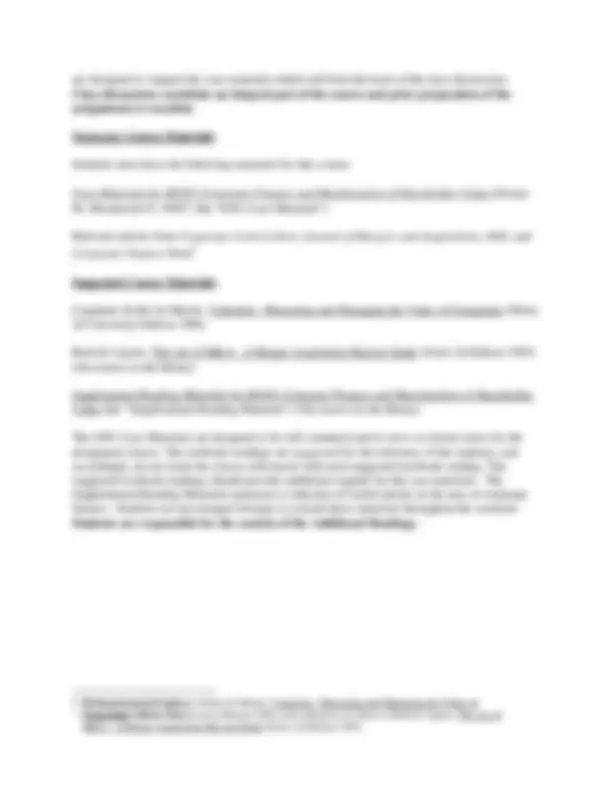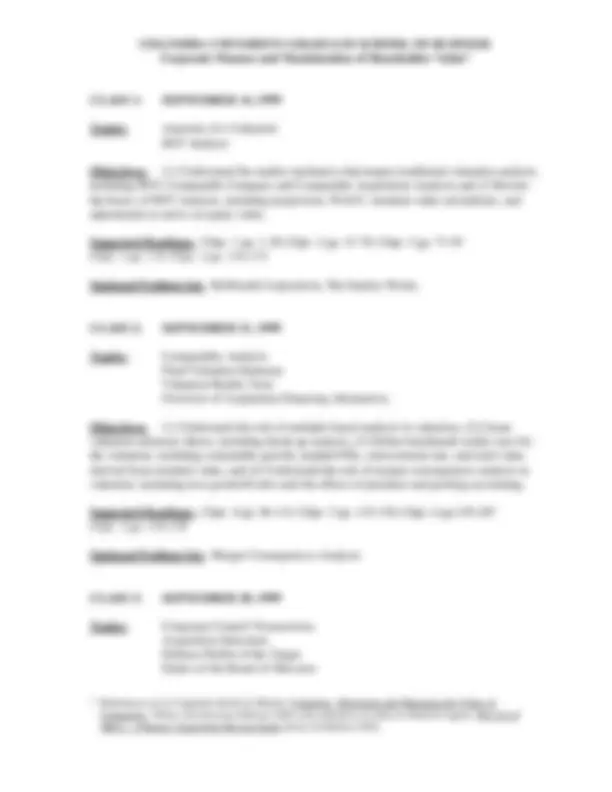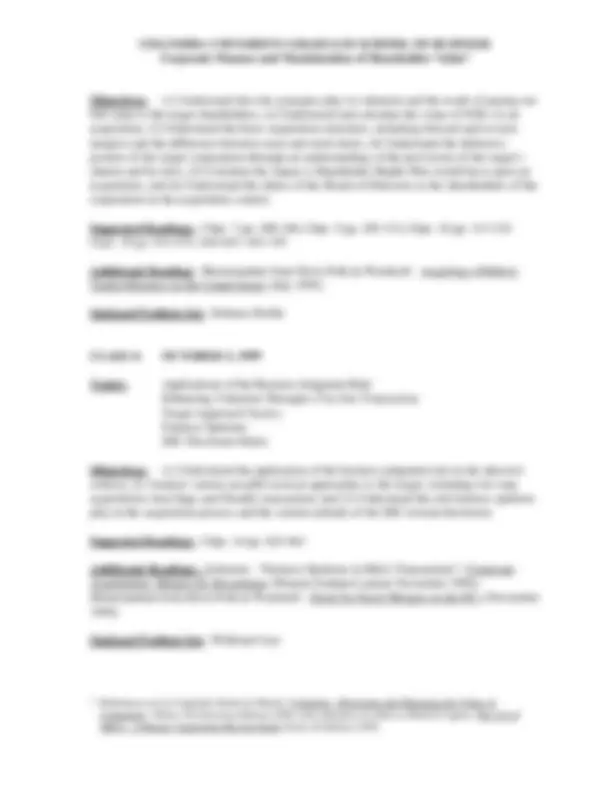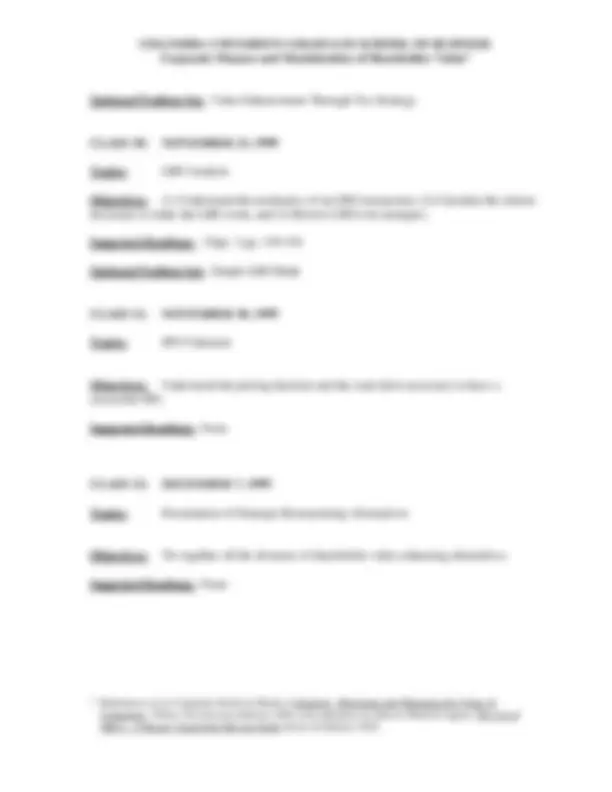






Study with the several resources on Docsity

Earn points by helping other students or get them with a premium plan


Prepare for your exams
Study with the several resources on Docsity

Earn points to download
Earn points by helping other students or get them with a premium plan
Community
Ask the community for help and clear up your study doubts
Discover the best universities in your country according to Docsity users
Free resources
Download our free guides on studying techniques, anxiety management strategies, and thesis advice from Docsity tutors
COLUMBIA UNIVERSITY GRADUATE SCHOOL OF BUSINESS ... Valuation Overview: Fundamentals and purpose of valuation analysis, including stand-.
Typology: Study notes
1 / 8

This page cannot be seen from the preview
Don't miss anything!





B8301-Corporate Finance Fall Term 1999 Donna M. Hitscherich Tuesday 6:20 P.M.- 9:10 P.M.
Content and Objective:
This course is designed to be an applications oriented course and will draw heavily on real world case studies. The course builds on the prior courses in corporate finance and will not introduce significantly different material than the student has been exposed to in the prerequisite introductory courses in finance at Columbia. Rather, the course will seek to apply basic finance principles to actual corporate finance problems likely to be encountered by senior management of major corporations or those who are the advisors to such management.
The theme of this course is Corporate Finance and Maximization of Shareholder Value with the focus of the course on the solution to problems encountered in the maximization of shareholder value questions facing the firm. At the conclusion of this course, the student should have an understanding of the major components of shareholder value. Topics covered will include:
Classwork :
Corporate finance principles will be imparted through lectures, assigned reading materials, optional problem sets, required written case studies, and presentations by various investment banking and legal professionals. Students will be expected to complete each of the assigned readings prior to class and consequently, be in a position to participate meaningfully in class discussions. Class lectures will focus on the "mechanics" of corporate finance, while student discussions will focus on the implications of the "mechanics" on practical corporate finance and managerial problems. While students must turn in their own individual work, students are encouraged strongly to work in groups on the required case studies.
Examinations :
There will be (1) three written case studies (in lieu of a mid-term exam), (2) one group presentation and (3) a final group presentation or a final exam. Students may elect to make a final group presentation or to take a closed book (with notes) comprehensive final exam. The final exam will be several essays which will be largely conceptual in nature. There will be a minimum and a “cap” established on the number of students who may elect the final group presentation option. If more than the allotted number of students select the group presentation option, a lottery will be employed to determine the students who will be able to make a final group presentation.
Evaluation of Performance :
Student grades will be based on the following formula: (1) Case Studies (45%), (2) Group Presentation (10%), (3) Final Presentation (40%) or Final Exam (40%), and (4) Class Participation (5%).
Readings :
Reading assignments must be completed prior to class. Before the next class, class time will be devoted to previewing the next assignment and the key concepts thereof. Reading assignments
Corporate Finance and Maximization of Shareholder Value*
Topics: Anatomy of a Valuation DCF Analysis
Objectives: (1) Understand the market mechanics that impact traditional valuation analysis, including DCF, Comparable Company and Comparable Acquisition Analysis and (2) Review the basics of DCF Analysis, including projections, WACC, terminal value calculations, and adjustments to arrive at equity value.
Suggested Readings: Chpt. 1 pp. 1-30; Chpt. 2 pp. 31-70; Chpt. 3 pp. 71- Chpt. 1 pp. 1-8; Chpt. 3 pp. 119-
Optional Problem Set: BellSouth Corporation, The Stanley Works
Topics: Comparables Analysis Final Valuation Summary Valuation Reality Tests Overview of Acquisition Financing Alternatives
Objectives: (1) Understand the role of multiple based analysis in valuation, (2) Create valuation summary sheets, including break-up analysis, (3) Define benchmark reality tests for the valuation, including sustainable growth, implied P/Es, reinvestment rate, and total value derived from terminal value, and (4) Understand the role of merger consequences analysis in valuation, including new goodwill rules and the effects of purchase and pooling accounting.
Suggested Readings: Chpt. 4 pp. 96-131; Chpt. 5 pp. 135-158; Chpt. 6 pp.159- Chpt. 3 pp. 119-
Optional Problem Set: Merger Consequences Analysis
Topics: Corporate Control Transactions Acquisition Structures Defense Profile of the Target Duties of the Board of Directors
Corporate Finance and Maximization of Shareholder Value*
Objectives: (1) Understand the role synergies play in valuation and the result of paying out full value to the target shareholders, (2) Understand and calculate the value of NOLs in an acquisition, (3) Understand the basic acquisition structures, including forward and reverse mergers and the difference between asset and stock deals, (4) Understand the defensive posture of the target corporation through an understanding of the provisions of the target’s charter and by-laws, (5) Calculate the impact a Shareholder Rights Plan would have upon an acquisition, and (6) Understand the duties of the Board of Directors to the shareholders of the corporation in the acquisition context.
Suggested Readings: Chpt. 7 pp. 208-246; Chpt. 9 pp. 285-312; Chpt. 10 pp. 313- Chpt. 10 pp. 631-672; 684-687; 691-
Additional Reading: Memorandum from Davis Polk & Wardwell - Acquiring a Publicly Traded Business in the United States (July 1995)
Optional Problem Set: Defense Profile
Topics: Applications of the Business Judgment Rule Enhancing Valuation Through a Tax-free Transaction Target Approach Tactics Fairness Opinions SEC Disclosure Rules
Objectives: (1) Understand the application of the business judgment rule in the takeover context, (2) Analyze various possible tactical approaches to the target, including two-step acquisitions, bear hugs and friendly transactions and (3) Understand the role fairness opinions play in the acquisition process and the current attitude of the SEC toward disclosure.
Suggested Readings: Chpt. 14 pp. 425-
Additional Readings: Solomon: “Fairness Opinions in M&A Transactions”, Corporate Acquisitions, Mergers & Divestitures (Warren Gorham Lamont November 1994); Memorandum from Davis Polk & Wardwell - Stock for Stock Mergers in the 90’s (November
Optional Problem Set: Williston Case
Corporate Finance and Maximization of Shareholder Value*
Topics: New Issues Market Mechanics of an Equity Offering IPO Valuation Effect on New Shareholders After-market Support
Objectives: (1) Understand how the given state of the general market can influence the IPO decision, (2) Review the mechanics of the new issue process, (3) Determine a framework for establishing a filing range for the IPO and the factors that influence the final pricing decision, (4) Understand the “economics” of an IPO for the old shareholders and “new” shareholders, and (5) Understand the importance of after-market support.
Suggested Readings: None
Optional Problem Set: DESI
Topics: Divestiture Mechanics and Process Tax Strategies Leveraged Joint Venture Spin-off / Spin-out/ Split-off Morris Trust Letter Stock Rights Offerings
Objectives: (1) Understand the divestiture decision, including the advantages and disadvantages of a public auction, (2) Analyze the benefits of a joint venture over a straight sale process, (3) Understand the mechanics of each of spin-offs, spin-outs, split-offs, and Morris Trusts, and (4) Understand how rights offerings and letter stock can be used to enhance shareholder value.
Suggested Readings: Chpt. 5 pp. 282-
Additional Readings: Excerpt from Federal Taxes and Management Decisions (Irwin 1995- 1996 Edition)
Corporate Finance and Maximization of Shareholder Value*
Optional Problem Set: Value Enhancement Through Tax Strategy
Topics: LBO Analysis
Objectives: (1) Understand the mechanics of an LBO transaction, (2) Calculate the returns necessary to make the LBO work, and (3) Review LBO exit strategies.
Suggested Readings: Chpt. 3 pp. 139-
Optional Problem Set: Simple LBO Math
Topics: IPO Valuation
Objectives: Understand the pricing decision and the road show necessary to have a successful IPO.
Suggested Readings: None
Topics: Presentation of Strategic Restructuring Alternatives
Objectives: Tie together all the elements of shareholder value enhancing alternatives.
Suggested Readings: None